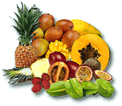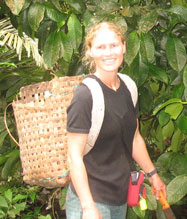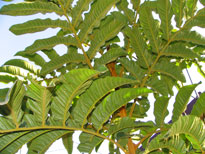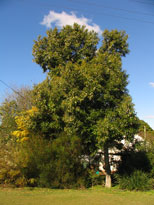
August 2006
The Daley News
 We welcomed Katie back from South America this month after four months abroad; we have all been enjoying her tales and adventures from the other side of the Pacific. Katie spent one month of her time away at a tropical and sub tropical orchard in the coastal rainforest of Ecuador . During this time Katie worked in the orchard collecting many different types of tropical fruits to sell the seeds internationally on the internet http://www.ecuadorexplorer.com/guaycuyacu/fruits_1.html Katie shared her skills as a propagator with both the orchard and local farmers, many of whom had never grafted trees before. Katie had the opportunity of grafting tropical trees that we are unable to grow here in Kyogle like the rambutan, langsat and mentang as well as having the opportunity to taste all the tropical flavours from South America.
We welcomed Katie back from South America this month after four months abroad; we have all been enjoying her tales and adventures from the other side of the Pacific. Katie spent one month of her time away at a tropical and sub tropical orchard in the coastal rainforest of Ecuador . During this time Katie worked in the orchard collecting many different types of tropical fruits to sell the seeds internationally on the internet http://www.ecuadorexplorer.com/guaycuyacu/fruits_1.html Katie shared her skills as a propagator with both the orchard and local farmers, many of whom had never grafted trees before. Katie had the opportunity of grafting tropical trees that we are unable to grow here in Kyogle like the rambutan, langsat and mentang as well as having the opportunity to taste all the tropical flavours from South America.
Fruit Tree of the Month
Sapodilla - Manilkara zapota
.jpg) The sapodilla is a beautiful slow growing, long lived evergreen tree that is well suited to the sub tropics as long as it can be provided with a frost free position. Sapodillas are native Central and South America, in particular to the
The sapodilla is a beautiful slow growing, long lived evergreen tree that is well suited to the sub tropics as long as it can be provided with a frost free position. Sapodillas are native Central and South America, in particular to the
.jpg) The fruits of the sapodilla are absolutely scrumptious; they are sweet and soft with a grainy texture like that of a pear. Fruits are small and egg shaped, they resemble a kiwi fruit on the outside being brown and slightly furry. The flesh inside is a beautiful translucent cinnamon colour, it can contain up to a dozen smooth shiny black seeds, these should not be eaten as they are not only toxic but also have a small hook on one end which can catch in the throat. The flavour of the ripe fruit is sweet like caramel or brown sugar, they have a delicious rich, melting, textured flesh which is at its best scooped straight from the skin with a teaspoon after the fruit has been slightly chilled.
The fruits of the sapodilla are absolutely scrumptious; they are sweet and soft with a grainy texture like that of a pear. Fruits are small and egg shaped, they resemble a kiwi fruit on the outside being brown and slightly furry. The flesh inside is a beautiful translucent cinnamon colour, it can contain up to a dozen smooth shiny black seeds, these should not be eaten as they are not only toxic but also have a small hook on one end which can catch in the throat. The flavour of the ripe fruit is sweet like caramel or brown sugar, they have a delicious rich, melting, textured flesh which is at its best scooped straight from the skin with a teaspoon after the fruit has been slightly chilled.
The most difficult thing about the sapodilla is picking the fruit when they are fully ripe, it can be quite hard to tell when this is as there is no significant colour change or softening to the fruit. Unripe fruit contain latex, are astringent and unpalatable. If the skin is brown and the fruit separates from the stem without leaking white latex the fruit is mature, however it needs to be kept at room temperature for a few days to soften. It should be eaten when the flesh is firm and soft but not mushy.
Sapodilla trees are very hardy once established and are easy to grow if given the right conditions; they are tolerant of salt conditions both around the roots and as spray making them an ideal tree for coastal environments. They are shallow rooted but despite this are tolerant of windy conditions and are able to thrive on poor soils. Because they are a slow growing tree they are well suited to containers and will happily produce bumper crops of fruit in a pot for many years, a grafted cultivar is the best choice if you wish to grow it in a pot as seedling trees can take up to eight years to begin fruiting.
Photos are from Pine Island Nursery, Miami in Florida.
Bush Food Of The Month
Native Tamarind - Diploglottis australis
 The native tamarind in one of my favourite rainforest trees. The large furry leaves are one of the largest in the Australian rainforest and are the most striking feature of this plant. The new growth is dark brown and velvety, as it shoots it looks like a kangaroo paw and is extremely attractive. Native tamarinds make a stunning potted specimen and can be kept small by cutting the stem back, they will happily reshoot. Young trees will grow straight up with a small whorl of leaves until they reach the
The native tamarind in one of my favourite rainforest trees. The large furry leaves are one of the largest in the Australian rainforest and are the most striking feature of this plant. The new growth is dark brown and velvety, as it shoots it looks like a kangaroo paw and is extremely attractive. Native tamarinds make a stunning potted specimen and can be kept small by cutting the stem back, they will happily reshoot. Young trees will grow straight up with a small whorl of leaves until they reach the .jpg) forest canopy when they start to branch. Large trees have a dense shady crown at the top of a tall straight trunk. The fruits are very attractive to native wildlife in particular fruit doves, pigeons, green catbirds and bower birds. Bats also relish the fruits and scrub turkeys will happily clean up any fallen fruit from the ground below the tree. The fruits are very tasty although sour; they can be used to make refreshing drinks and desserts. Native tamarinds are related to the lychee, rambutan and longan of Asia.
forest canopy when they start to branch. Large trees have a dense shady crown at the top of a tall straight trunk. The fruits are very attractive to native wildlife in particular fruit doves, pigeons, green catbirds and bower birds. Bats also relish the fruits and scrub turkeys will happily clean up any fallen fruit from the ground below the tree. The fruits are very tasty although sour; they can be used to make refreshing drinks and desserts. Native tamarinds are related to the lychee, rambutan and longan of Asia.
Tubestock of the Month
Red Ash - Alphitonia excelsa
 The red ash is a fantastic fast growing pioneer tree that is widely planted in both rainforest plots and woodlots as it also has a durable red timber that can be used for tool handles, building and cabinet work. The tree is attractive although it often has a bug eaten appearance as many insects feed on the foliage; these insects in turn attract insect eating birds. The fruits are attractive to other types of birds so it is an excellent wildlife tree. The red ash is used as a fodder tree for both sheep and cattle. Indigenous Australians had many uses for the red ash especially as a medicine. The crushed leaves were applied to the temples to relieve headaches and sore eyes. An infusion of the bark and roots was used as a gargle for toothache, upset stomachs, bites and stings were also treated using the red ash tree. The crushed leaves and berries were used as a fish poison.
The red ash is a fantastic fast growing pioneer tree that is widely planted in both rainforest plots and woodlots as it also has a durable red timber that can be used for tool handles, building and cabinet work. The tree is attractive although it often has a bug eaten appearance as many insects feed on the foliage; these insects in turn attract insect eating birds. The fruits are attractive to other types of birds so it is an excellent wildlife tree. The red ash is used as a fodder tree for both sheep and cattle. Indigenous Australians had many uses for the red ash especially as a medicine. The crushed leaves were applied to the temples to relieve headaches and sore eyes. An infusion of the bark and roots was used as a gargle for toothache, upset stomachs, bites and stings were also treated using the red ash tree. The crushed leaves and berries were used as a fish poison.





